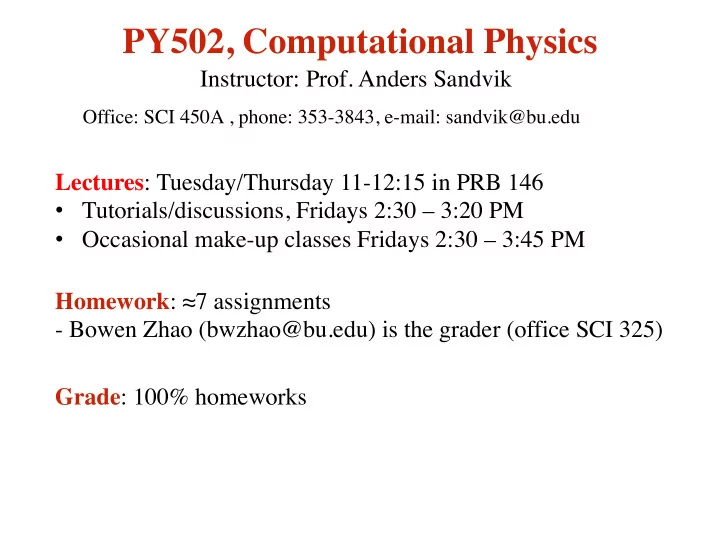

PY502, Computational Physics Instructor: Prof. Anders Sandvik Office: SCI 450A , phone: 353-3843, e-mail: sandvik@bu.edu Lectures : Tuesday/Thursday 11-12:15 in PRB 146 • Tutorials/discussions, Fridays 2:30 – 3:20 PM • Occasional make-up classes Fridays 2:30 – 3:45 PM Homework : ≈ 7 assignments - Bowen Zhao (bwzhao@bu.edu) is the grader (office SCI 325) Grade : 100% homeworks
Course web site http://physics.bu.edu/py502 - Lecture notes - Lecture presentations - Example program - Homework assignments and solutions - Messages ( “ Course News ” ) Submitting homework Use e-mail to submit programs: py502@buphy.bu.edu - Include the program(s) as attachment(s)! - Name your programs: e.g., hwx_lastname.f90 Turn in write-up (hardcopy) report to instructor or grader Some discussion/collaboration on homework problems is allowed, but each student has to turn in her/his independently written programs and reports.
Computers and programming language § Bring your own laptop to class if possible - operating system: linux/unix (similar under OSX) - install emulator software if you use Windows - computer help from Guoan Hu (office PRB 453) § Fortran 90 and Julia will be used in lectures § You can possibly use other languages for homeworks § Introduction to Fortran 90 & Julia will be given (~4 lectures) § Extensive background in programming not needed § Some Unix/Linux knowledge assumed (e.g., text editing) § Come to office hours if you need help!
Lecture notes • Will be posted on the web site ahead of the lectures • No additional required text Recommended reading • Computational Physics, by J. M. Thijssen • Computational Physics, by N. J. Giordano and H. Nakanishi • Fortran 90/95 Explained, by M. Metcalf and J. Reid • Fortran 90/95 For Scientists and Engineers, by S. Chapman • Numerical Recipes, by W. H. Press et al. (free on-line with codes in many languages: http://www.nr.com/) On-line resources (e.g., Julia); see course web site
What is computational physics? • “ Scientific computing ” in physics • Studies of models of physical systems using computers - Numerical solutions of equations that cannot be done analytically - Direct studies of models to “ simulate ” a system • Most subfields of physics use some computations, e.g., - Dynamics of solar systems, galaxies, etc - Studies of mechanical models of earthquakes - Fluid dynamics; turbulence - Molecular dynamics of gases, fluids - Electrostatics and dynamics (Maxwell ’ s equations) - Electronic structure of materials - Statistical mechanics of polymers, magnetic systems, etc. - Lattice gauge theory (numerical QCD) Some times considered third “ branch ” of physics • - Experimental, theoretical, computational • Most physicists need to do some computational work
Topics covered in PY502 • The Fortran 90/95 and Julia programming language • Numerical integration • Numerical solution of differential equations - classical and quantum mechanics problems • Monte Carlo simulations (statistical mechanics) • Basic methods for quantum many-body (lattice) systems Goals • Learn the basics of the above techniques • Gain proficiency in scientific computing in general
Teaser: The last topic of the course will combine several of the previous methods we have learned to study: Quantum Annealing (a paradigm for quantum computing) You will learn what is going on (supposedly…) in machines made by D-wave, Google,….
Recommend
More recommend